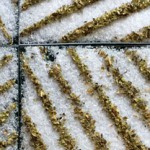In April of 2011 my wife and I celebrated our one-year anniversary by taking a road trip. Our turnaround point was Memphis and there were many stops along the way, but the most notable stop was Franklin, Tennessee. Union University was hosting their ACT Conference. (ACT stands for art, culture and theology.) This wasn’t originally in my plans. I say “my” plans because Kate likes when I plan our road trips and surprise her day to day as the trip unfolds. Kate had stumbled upon the news of this conference and ran it by me. I told her it just wasn’t possible because I had already booked non-refundable rooms in other cities for those dates. Well, the holders of those bookings were generous in letting me change the dates, and this two-day conference ended up being the highlight of our trip.
Here we were introduced to an amazing lineup of speakers, curators and artists: Nigel Goodwin, Mary McCleary, David Taylor, Michael Winters, and more. The final speaker of day one was Dan Siedell. I wasn’t prepared for Dan. He was the director of the Miami-based studio of artist Enrique Martínez Celaya, and he used this artist and his interaction with this artist as a case study of sorts. He also discussed very controversial works of art (such as “Piss Christ”) and challenged us to go beyond our initial gut reaction. He spoke of “hamster ball theology.” It was challenging. It was deep. At the time I felt his gravitas didn’t fit in with the rest of the conference. But his presentation has stuck with me over the past two and a half years, far more than any other speaker from that conference.
I later started following him on Twitter and have learned to appreciate Dan even more. Just last month he was appointed as Presidential Scholar and Art Historian in Residence at The King’s College. He posted a link to the press release, which includes a video of an interview with the president of the college. You can watch the video here. In the video, Dan states the following:
The evangelical church in many ways just doesn’t know how to use art. They want to use it and they want to make it work somehow for the kingdom and they have an end, and it just doesn’t behave the way we want it to behave.
And so an important part of my project is for me to create a space for people to just dwell in that brokenness, dwell in the complexity, dwell in the ambiguity of experiencing a work of art and not have to feel the pressure to make it useful for the kingdom. God is at work in the world, He’s busy at work in the world and I believe He’s busy at work in the world in the experience that I have in front of paintings.
My wife and I are both fine artists. For Kate it’s more of a full-time deal. For me, it’s usually when my design business is slow or when I agree to take on a piece for a specific exhibit. And we’re both followers of Christ. As a result, the issues Dan raises here have been our pet issues from the start of our relationship. The pursuit of those answers has shaped our artwork and has led to even more questions.
In addition to being artists, we’re also performers. I’m a juggler and my wife is a clown. Together we perform 45-minute stage shows both inside and outside of the church. We’re proud of our show and enjoy the challenges and the dynamic this adds to our lives—but that same issue plagues us. We want to use our talents for the kingdom. But how? We’re not looking to tag a Bible verse onto the end of each show and call it “Christian.” We recently had coffee with Chris Ivey, a world champion juggler and a Christian. We asked him, “How do we glorify Christ through our shows?” His reply was to the point. “Your show is not a sermon.” He went on to say that any direct influence he’s had on people has come through personal interaction after the show.
A couple weeks ago I spent five days in Chicago, attending the Harvest University conference. My home church recently became a Harvest Bible Chapel, and I was attending to learn more about how they do things, with a focus on their design and communications track. But my main curiosity was how they incorporated fine art, if at all. I had some good conversations which go beyond the scope of this post, but I discovered this large organization has the same issues and the same struggles that Kate and I have and that Dan raises. But one conclusion they had decisively landed on is that a person’s participation in and contribution of art within the church should never take the place of their discipleship and learning within the church community. So while they use art in creative ways within the church (usually through worship times), they no longer have a regular meeting of artists as they found it kept many of these artists from getting involved in a small group, serving instead as a replacement.
I think it’s important to emphasize that for the artist, the creation of art should never be a replacement for face-to-face interaction, whether inside or outside the church. I’m not offering that statement as an answer, reply or resolution to Dan Siedell’s beautiful statement above. I’m in total agreement with his statement and am comforted to hear his words, as I was comforted to hear that a large church in Chicago has the same struggles and challenges as a recently-married couple in Lancaster, Pennsylvania. And so, with the backing of those I admire, I joyfully dwell in the brokenness, the complexity and the ambiguity.



